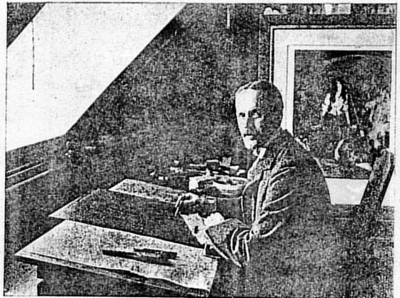
Herbert Thomas Dicksee stands as a significant figure in British art, particularly renowned for his sensitive and powerful depictions of animals. Active during the late Victorian and Edwardian periods, his work captured the public imagination and continues to be appreciated by collectors and art lovers today. His life and career were deeply intertwined with a prominent artistic family, providing a rich background against which his unique talents flourished.
An Artistic Heritage
Herbert Thomas Dicksee was born in London on June 14, 1862. Artistry was in his blood. His father, John Robert Dicksee (often cited simply as John Dicksee), was a painter, known for his genre scenes and portraits. His uncle, Thomas Francis Dicksee (often cited as Thomas Dicksee), was also an established artist, specializing in historical and literary subjects, as well as portraits. This familial immersion in the art world undoubtedly shaped Herbert's path from a young age.
Perhaps the most famous member of the family was Herbert's cousin, Sir Frank Dicksee. Frank achieved considerable fame for his dramatic historical and legendary scenes, often imbued with a Pre-Raphaelite intensity. He rose through the ranks of the art establishment, eventually serving as President of the Royal Academy of Arts from 1924 until his death in 1928, receiving a knighthood in 1925. Growing up amidst such artistic activity provided Herbert with both inspiration and a high standard to aspire to.
Education and Early Career
Following the family tradition, Herbert pursued formal art training. He enrolled at the prestigious Slade School of Fine Art in London, an institution known for its rigorous emphasis on drawing from life. This training honed his observational skills and technical proficiency, laying the groundwork for his future specialization in animal subjects.
Dicksee began exhibiting his work relatively early in his career. His first public showing is recorded as being in 1881, when he would have been just nineteen years old. This marked the beginning of a long and productive career during which he would become a regular contributor to major London exhibitions, most notably the Royal Academy's annual Summer Exhibition.
Style and Subject Matter: A Dedication to Animals
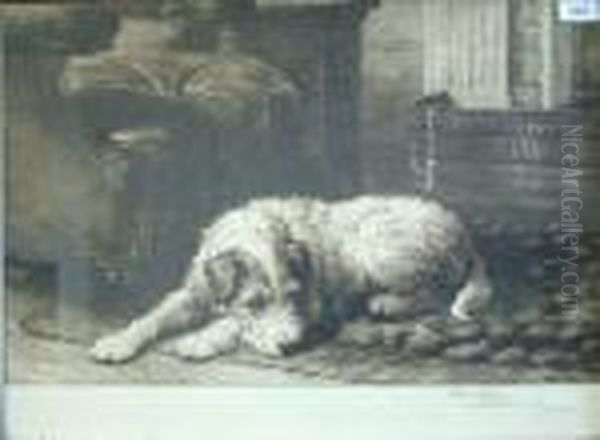
While capable in various genres, Herbert Dicksee found his true calling in the depiction of animals. He possessed an extraordinary ability to capture not just the physical likeness of his subjects, but also their individual character, mood, and vitality. His primary focus was on dogs, ranging from beloved domestic pets to working breeds and hounds, but his repertoire extended significantly to wild animals, particularly large cats like lions, tigers, and panthers.
His approach was rooted in realism and direct observation. Dicksee was known to keep numerous dogs as pets, and these animals frequently served as models for his paintings and etchings. This intimate familiarity allowed him to portray them with genuine understanding and affection. His depictions often convey a sense of personality and inner life, elevating them beyond mere anatomical studies.
For his depictions of wild animals, Dicksee was a frequent visitor to the Zoological Gardens in London (now London Zoo). He spent considerable time sketching and studying the animals there, particularly the big cats housed in the Lion House. This dedication to observing animals in life lent an authenticity and dynamism to his work that distinguished him from artists who relied solely on secondary sources or taxidermy. His connection to the zoo was formally recognized when he was made an Honorary Fellow of the Zoological Society of London.
Dicksee's style aligns broadly with the traditions of Victorian realism. He paid meticulous attention to detail, rendering fur, muscle structure, and expressive features with great care. While working in the same era as the later Pre-Raphaelites, and sharing their commitment to detailed observation, his work generally avoided the overt symbolism or literary narratives often found in Pre-Raphaelite painting. Instead, his focus remained firmly on the animal itself, presented naturally within its environment, whether domestic or wild. There's often a romantic sensibility in his portrayal of the nobility or untamed spirit of animals, but it is grounded in realistic representation.
Master Etcher and Illustrator
Beyond his oil paintings, Herbert Dicksee was a highly accomplished etcher and illustrator. Etching, a printmaking technique involving drawing through a wax ground on a metal plate which is then bitten by acid, allowed for fine detail and rich tonal variation. Dicksee mastered this medium, producing numerous plates that were widely published and became incredibly popular with the public.
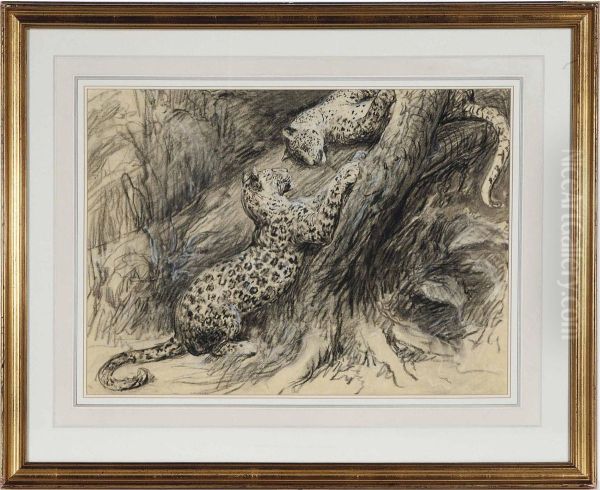
His etchings often reproduced his most successful paintings or were created as original compositions. Subjects ranged from intimate portraits of dogs and cats to dramatic scenes of lions and tigers in the wild. These prints were praised for their technical brilliance, capturing textures and the play of light and shadow with remarkable skill. Publishers like Frost & Reed issued many of his etchings, often as signed, limited-edition prints, making his work accessible to a broader audience beyond those who could afford original oil paintings.
The popularity of these etchings contributed significantly to his reputation. Works like "Where's Master?" became iconic images, cherished by animal lovers. He also undertook illustration work, contributing drawings to books and periodicals, further demonstrating his versatility and skill in black and white media. His charcoal and watercolour studies, such as the preparatory work for pieces like "Two Panthers," also reveal his confident draughtsmanship and understanding of form.
Representative Works
Several works stand out as particularly representative of Herbert Dicksee's oeuvre and enduring popularity:
_Where’s Master?_: This etching is arguably one of Dicksee's most famous works. It depicts Caesar, the Wire Fox Terrier belonging to King Edward VII, mourning his master following the King's death in 1910. The dog rests its head faithfully on the King's favourite armchair. The image struck a chord with the public, capturing themes of loyalty and loss, and became immensely popular, widely reproduced and cementing Dicksee's reputation as a master of canine portraiture.
_Two Panthers_: This work, executed in charcoal and watercolour, showcases Dicksee's skill in depicting wild felines. It portrays two black panthers gazing intently at each other, conveying a sense of coiled energy, mystery, and primal connection. The piece is noted for its strong emotional impact and the artist's ability to suggest the animals' inner state.
_The Destroyers_: An etching featuring two formidable tigers standing alertly on a rocky outcrop, overlooking a landscape below. This work exemplifies Dicksee's ability to convey the power, majesty, and potential danger of wild animals. The detailed rendering of the tigers' stripes and musculature, combined with the dramatic composition, makes it a powerful image.
_Stealth_: A print depicting a cat moving silently through grassy undergrowth, embodying the feline predator's focused intensity and silent movement. This work highlights Dicksee's skill in capturing characteristic animal behaviours and creating atmospheric scenes.
_Carrying Wool - Canterbury, New Zealand_: This etching demonstrates Dicksee's capability beyond purely animal portraits, depicting a scene of bullock teams hauling wagons laden with wool bales across the New Zealand landscape. It showcases his ability to handle landscape elements and narrative scenes involving animals in a working context.
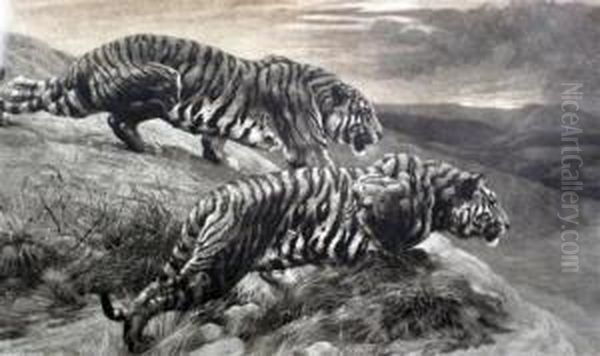
_Victory (Lion Choking A Large Python)_: A dramatic composition showing a powerful male lion overcoming a large python. This work explores themes of struggle, dominance, and the raw power of nature, subjects that resonated with the Victorian and Edwardian fascination with the natural world's more dramatic aspects.
These examples illustrate the range of Dicksee's subjects and his consistent ability to capture the essence of the animals he portrayed, whether domestic companions or wild predators.
Career, Recognition, and Teaching
Herbert Dicksee enjoyed a successful and respected career. He exhibited regularly at the Royal Academy from 1881 onwards, showcasing his oils and etchings to a wide audience. His work was generally well-received by critics and the public alike, particularly his animal subjects.
His expertise was recognized through memberships in prestigious art societies. Sources indicate he was associated with bodies such as the Royal Society of British Artists (RBA) and potentially the Royal Watercolour Society (RWS), reflecting his standing within the London art world. His aforementioned Honorary Fellowship of the Zoological Society of London further underscored his reputation as a pre-eminent animal artist.
Dicksee also dedicated part of his career to teaching. He served as a drawing and painting instructor at the Royal College of Art (some sources mention the Royal Academy Schools, clarification may be needed but a teaching role is confirmed) for a significant period. Records suggest he began teaching around 1895 and continued until his retirement in 1927. This role allowed him to pass on his skills and knowledge to a new generation of artists.
The Dicksee Family Context
It is impossible to fully appreciate Herbert Dicksee's career without considering the context of his extraordinarily artistic family. His father, John, and uncle, Thomas, were established figures in the Victorian art scene. Their success provided a supportive environment and likely facilitated Herbert's entry into the art world.
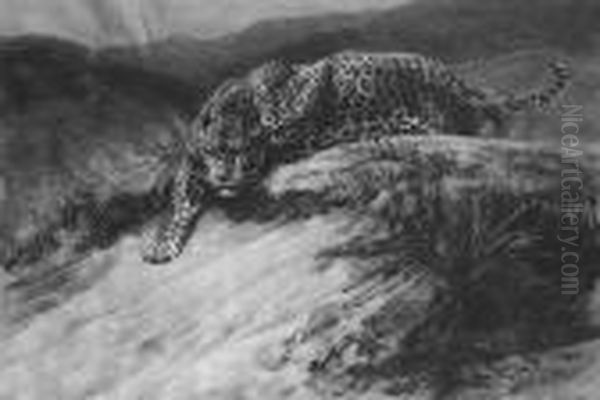
The towering figure, however, was his cousin, Sir Frank Dicksee. Frank's trajectory was stellar – a highly popular painter, elected to the Royal Academy relatively young, and eventually reaching its highest office as President. While Frank focused on historical, allegorical, and society portraits, often with a more polished and sometimes sentimental finish, Herbert carved his niche in the specialized field of animal painting. There is no record of professional rivalry; rather, they seem to have pursued parallel paths within the same artistic milieu, each achieving success in their chosen domain. The shared surname, however, meant Herbert's work was sometimes viewed in the shadow of his more famous cousin.
Herbert Dicksee in the Victorian Art World
Herbert Dicksee worked during a dynamic period in British art. The Victorian era saw a huge appetite for various forms of realism, narrative painting, and subjects drawn from modern life, history, and the natural world. Animal painting, in particular, enjoyed immense popularity, building on the legacy of earlier artists.
Dicksee's contemporaries included a host of talented artists exhibiting alongside him at the Royal Academy and other venues. Within the specific field of animal painting, artists like Sir Edwin Landseer (though earlier, his influence was profound) and Briton Rivière were prominent figures known for their often anthropomorphic and narrative depictions of animals.
The broader context included leading figures of the establishment like Frederic Leighton (President of the Royal Academy before Frank Dicksee) and Lawrence Alma-Tadema, known for their classical scenes, and portraitists like John Singer Sargent. The legacy of the Pre-Raphaelite Brotherhood, including Dante Gabriel Rossetti, John Everett Millais, and William Holman Hunt, continued to influence aesthetic sensibilities regarding detail and emotional intensity, elements echoed in Dicksee's meticulous approach. Other major figures of the era included George Frederic Watts and Edward Burne-Jones. Herbert Dicksee navigated this complex and competitive art world, establishing his own distinct voice and loyal following through his specialization. His father John Dicksee, uncle Thomas Dicksee, and cousin Sir Frank Dicksee were, of course, direct familial contemporaries within this scene.
Personal Glimpses and Later Life
Details about Herbert Dicksee's personal life beyond his artistic practice are relatively scarce. His dedication to his craft seems to have been paramount. His frequent visits to the London Zoo and the presence of numerous dog models in his home point to a life deeply intertwined with the animals he loved to paint and draw.
Available records confirm he had a daughter named Dorothy. Upon his death, Dorothy Dicksee served as the executor of his will, suggesting a close family relationship. However, unlike some artists whose lives are documented through extensive correspondence or diaries, Dicksee appears to have been a more private individual. No significant caches of personal papers revealing anecdotes or unpublished stories have come to light, leaving his art as his primary testament.
Herbert Thomas Dicksee continued to work into his later years, though the artistic landscape began to shift with the rise of modernism in the early 20th century. The detailed realism he practiced became less fashionable in avant-garde circles. Nevertheless, his work retained its popular appeal, particularly his etchings, which continued to be collected.
He died on February 20, 1942, in Hampstead, London, at the age of 79.
Legacy and Conclusion
Herbert Thomas Dicksee left behind a substantial body of work characterized by technical skill, keen observation, and a profound empathy for the animal kingdom. While perhaps overshadowed in art historical narratives by his more famous cousin Frank, or by the rise of modernist movements, Herbert secured a lasting reputation within his specialized field.
He is remembered as one of the foremost animal artists of the late Victorian and Edwardian eras. His paintings, and especially his widely circulated etchings, captured the beauty, power, and personality of animals in a way that resonated deeply with the public. His dedication to studying animals from life, whether his own pets or the inhabitants of the London Zoo, imbued his work with an authenticity and vitality that continues to appeal. For collectors of animal art and enthusiasts of traditional printmaking techniques, Herbert Thomas Dicksee remains a highly regarded and sought-after name. His art serves as a testament to a lifelong fascination with the animal world and a mastery of realist representation.